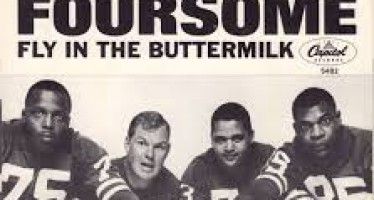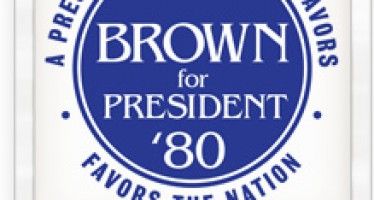Retrospective: Pork OD Kills Water Project
DEC. 1, 2010
By RICHARD TRAINOR
When former San Francisco Mayor and California Assembly Speaker Willie Brown said that a “political earthquake” is rumbling in the Central Valley over water he was right on the money, and it seems that big money was driving the water bond process right from the start.
The history behind the water bond initiative removed from this year’s ballot in June and rolled over until 2012 is illuminating. It was one of the sleaziest proposals put forward in recent memory.
It was billed as the Delta Vision, but the vision put forward by Arnold Schwarzenegger and other key peripheral canal backers like Sen. Dianne Feinstein and agribusiness billionaire and water banker Stewart Resnick would have benefited its backers while costing Californians as much as $50 billion.
On May 18, Feinstein delivered her requests for the 2010 Water Resources Development Act. Feinstein itemized the expenditures for the water bonds: over a billion dollars in federal funds related to expanding the California Water Project with peripheral canals to carry water from the Sacramento-San Joaquin Delta to commercial developers in Southern California. One of the projects itemized by Feinstein was the Syphon Reservoir Recycled Water Storage Project at a cost of $60 million.
Syphon Reservoir is owned by the Irvine Ranch Water District. Feinstein’s letter closed with the following declaration: “I certify that neither I nor my immediate family has a pecuniary interest in the items that I have requested, consistent with the requirements of paragraph 9 of Rule XLIV of the Standing Rules of the Senate.”
A blue ribbon panel focused on the issue and appointed by Governor Arnold Schwarzenegger was stacked with corporate insiders with a financial stake in the process, including representatives from TPG Capital, one of the world’s hugest venture capital corporations. TPG Capital is partly owned by Richard C. Blum, Senator Feinstein’s husband.
TPG Capital (formerly Texas Pacific Group) is the largest private equity investment firms globally, managing more than $350 billion in assets. TPG manages investment funds specializing in public equity and debt investments, like the water project bond issue. In fact, they’re one of the firms with a contract with the California Department of Water Resources, the lead agency on the water project.
Besides TPG, a number of other engineering and design firms who are major providers of California’s infrastructure were in line for some pork. Among them were Bechtel, Parsons-Brinckerhoff and URS, an engineering-and-design corporation owned by Richard Blum until 2005. All of them have contracts on the water project, which will continue despite the initiative’s rollover until 2012.
Delta citizens and business owners most affected by the peripheral canal proposal felt they were left on the sidelines. “The whole thing stunk to high heaven,” said Democratic Sen. Lois Wolk of Davis, an opponent of the canal project. “It was a pig with lipstick and we‘re lucky it fell apart.”
In February 2007, Schwarzenegger formed a Blue Ribbon Task Force to look into building a new peripheral canal. The seven-member task force was chaired by Phil Isenberg, a former mayor of Sacramento who then became a lobbyist. One of his firm’s biggest clients was The Irvine Company. Other task force members included Monica Florian, formerly with the Irvine Company, Sonne McPeak, another former legislator, and William Reilly, of TPG Capital.
The place Schwarzenegger chose to outline his water vision was the Willie L. Brown Jr. Institute of Politics and Public Service on Nov. 3, 2009, while the water bond bill, SB1, was proceeding through the Legislature. Arnold compared himself to former Gov. Pat Brown and laid claim to being Brown’s water vision successor.
“Pat Brown was a great visionary, (but) one of the very important parts and important pieces of the puzzle really never got built, which was the (peripheral) canal,” he said. SB1 was passed by the Legislature the day after Schwarzenegger made his pitch at the Institute.
Opponents of Schwarzenegger’s plan included the Sierra Club, the Friends of the River and the Planning and Conservation League. Critics say some environmental groups such as The Nature Conservancy had been co-opted by canal backers during the battle, prompting one journalist to coin a wonderful new phrase. They were “green washers,” as Dan Bacher characterized the environmental sanitizers.
In a Feb. 16, 2010 article, Bacher wrote, “Resnick was heavily involved in the creation of Kern County Water Bank, a controversial underground water storage facility in the southern San Joaquin Valley. The Westside Mutual Water Company, owned by Resnick, now owns 48 percent of the bank. One of the reasons why Central Valley reservoirs were drained so low over the past few years was to fill the water bank and southern California water reservoirs.”
The article further reported: “The Resnicks have also written big checks to the campaigns of Governor Arnold Schwarzenegger, Senator Dianne Feinstein, and presidential candidates from both parties in the 2008 election. They contributed a total of $271,990 to Schwarzenegger’s campaign coffers.”
According to figures on file with the Federal Elections Commission, the amount that Resnick and his family and associates have contributed to Feinstein from 2005 (when the water project bond issue began to heat up) until June, when Schwarzenegger tanked the project is more than $200,000.
Feinstein pressured the Obama administration to overturn protections of the Central Valley salmon and Delta smelt, both of which were threatened if the canal went forward. Resnick was grateful for her action. “I really appreciate your involvement in this issue,” he wrote in a Sept. 4, 2009 letter to Feinstein. The administration heeded Feinstein’s urging and removed the protections.
Resnick was generous to Democratic governor-elect Jerry Brown as well. Resnick wrote four checks totaling $50,000 to the Brown gubernatorial campaign. Brown’s campaign spokesman didn’t respond to this reporter’s phone calls for comment.
The Planning and Conservation League had a civil war over the water bonds when a dissident wing headed by Jerry Meral battled the PCL executive board. Meral, the former executive director of the PCL, wanted the PCL to remove its opposition. In a conference call on June 14, 2010, the PCL turned the Meral challenge aside and reiterated its opposition to the canal. The next day, Schwarzenegger bailed on the water bond initiative for 2010.
“They figured they couldn’t battle for the water bonds and for Proposition 23 at the same time,” said V. John White, a lobbyist who closely followed the water bonds. “They had to go with one or the other and they went with 23.”
So Schwarzenegger terminated the initiative and handed it off to his successor.
Perhaps canal backers should count their blessings. They avoided a scandal that might have erupted had the initiative gone forward. “The size and content of the project was the main problem that we had with the water bond initiative,” said Tina Andolini of the Planning and Conservation League. “It was that and the fact that it was set up to benefit the wealthy like Resnick.”
The water bond initiative is analogous to a number of other pork-heavy public works projects involving Feinstein and corporations owned by Blum. These projects include the $10 billion Bay Bridge, the proposed $43 billion high-speed rail project and the proposed $3 billion expansion of the San Francisco Airport. All these projects also involved URS when Blum owned it. Blum took URS to the Number One engineering-and-design firm in the world before he sold it in 2005.
So, instead of the cash-generating whir of hydraulic drills and the drone of diesel engines pumping money into the California economy, the sounds that the water bond backers are hearing is the metallic screech of a train coming off the tracks. California voters were opposed to the water bonds by a 3-2 margin when the first polls were taken in January of this year. The numbers were exactly the same in June when Schwarzenegger pulled the plug.
Schwarzenegger’s other pet project, which he also touted at the Willie Brown Institute is high-speed rail, is also in danger of being derailed. The project is mired in litigation and strangled by sleaze. Jerry Brown still supports high-speed rail. State Treasurer Bill Lockyer, who would have to approve the sale of the rail bonds, does not. As he told the San Diego Union-Tribune editorial board in July, “There are dozens if not hundreds of infrastructure investment funds on the planet. (The California Public Employees’ Retirement System), as an example, recently bought a significant piece of a London airport. There are a lot of infrastructure funds like that that are public and private, probably trillions of dollars looking for good deals. So there’s financing potentially available if it’s a good deal. I’m just not yet convinced the investors are going to think that’s a smart investment to make.”
Feinstein was asked to comment on the possible conflict of interest regarding her husband Richard Blum and his ownership of TPG Capital, whose press spokesman, Owen Blicksilver, holds a similar position with Blum Capital Partners. Phone calls and e-mails to Blicksilver and Gil Duran, Feinstein’s spokesperson seeking comment didn‘t receive a reply.
Related Articles
1st and goal for NFL in L.A.
After years of speculation, planning, wrangling and setbacks, pro football is as close to returning to Los Angeles as it’s
Suddenly, buzz is back for Brown 2016
In just a handful of weeks, speculation has returned, and hype has built, around the idea of a Jerry Brown candidacy




